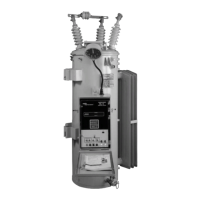
Do you have a question about the Cooper McGraw-Edison VR-32 and is the answer not in the manual?
| Category | Controller |
|---|---|
| Type | Voltage Regulator |
| Model | VR-32 |
| Manufacturer | Cooper McGraw-Edison |
| Frequency | 60Hz |
| Phase | Single |
General safety guidance and procedures for operating and maintaining the regulator.
Explanation of hazard symbols (Danger, Warning, Caution) used in the manual.
Procedures for inspecting the regulator shipment for damage and shortages.
Checks to perform on the regulator before connecting it to the line.
Method to identify phase shift for delta connections to ensure correct regulator configuration.
Steps for connecting and energizing the regulator without interrupting load.
Procedure for programming the regulator's control system parameters.
How to access control settings and activate security levels.
Configuration of key parameters like voltage, bandwidth, and time delay.
Selecting how the control responds to voltage deviations (Sequential, Time Integrating, Averaging).
How the control logic handles bidirectional power flow.
Description of controls in the lower part of the regulator control panel.
Description of the LCD display and keypad interface.
Procedures to verify control and regulator functionality.
Process for calibrating voltage measurement accuracy on the control.
Process for calibrating current measurement accuracy on the control.
Diagnosing issues where the regulator fails to operate.
Steps for diagnosing problems within the regulator control system.
Specific troubleshooting steps for the junction box components.
Overview of spring-drive, direct-drive, and quik-drive tap changer types.
Description of contact structures, materials, and wear limits.
Step-by-step explanation of the spring-drive tap changer mechanism.
Information on interface boards for SCADA connectivity.
Using Data Reader and PC software for data management.
Required information for ordering replacement parts and accessories.
